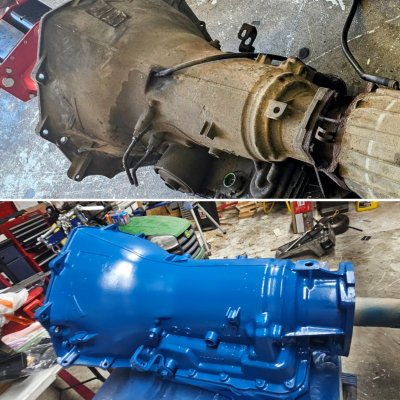| Problem/Symptom | Cause | Fix | Notes |
| No movement in any range (forward or reverse) | Pump failure
Input shaft splines stripped
Converter failure
Low roller and sun shell failure
Burnt forwards+coast clutch+low reverse/reverse input | Replace whichever parts at left failed | Check dipstick level off then start engine - if dipstick level is way above full w/engine running pump has failed
If not, put pressure gauge on trans - if pressure is normal, tear down and inspect transmission to PID cause. |
| No Reverse, 2nd or 4th gear | Sun shell failure
Rear gear train failure | Replace sun shell and/or gear train on overhaul
Always use hardened / heat treated sun shell at minimum (Sonnax Smart Shell recommended if budget allows for it) | Gear train failure can first present as vehicle ‘locking up’ in reverse or first gear as pieces of gear teeth are preventing mesh of gear components
Momentary neutral conditions at highway speeds also indicate progressive gear train failure |
| No Reverse; all forward gears work | Lip seals on reverse input piston and/or low reverse piston worn | Replace lip seals on overhaul | Common when trans overheats multiple times or not driven for long periods of time (also affects other seal surfaces) |
| No forward movement in Drive but forward movement in Manual 2 and 1; reverse works | Input sprag failed
Input sprag installed backwards (overhaul only) | Replace input sprag gear assembly
Correct sprag orientation | Sprag clutch, inner and outer race must all be replaced in the event of sprag failure
Use 400 grit sandpaper on inner dia of replacement outer race to prep surface before installing new sprag clutch |
| No upshift from 1st gear at all (1992-E2006) | Failed output speed sensor or speed sensor harness short-to-ground | Confirm it’s plugged in
Replace speed sensor
Fix/replace ext harness | Check harness and related wiring for shorts or damaged wires and verify pigtail is receiving voltage |
| No upshift from 1st gear at all (L2006) | Failed input speed sensor,
output speed sensor
or internal harness short-to-ground or external short to ground | Confirm it’s plugged in
Replace speed sensor
Fix/replace harness | Transmission must be removed from vehicle, pump extracted to replace input speed sensor (aka Turbine speed sensor) |
| No upshift from 1st gear - eventually shifts to third | 2nd gear Servo piston/sealing rings
Worn/burnt 2-4 band | Replace rings or Servo assembly w/093 servo | Air check 2nd gear apply to confirm / deny the servo is the problem |
| No forward movement in any range setting - reverse works | Failed low roller clutch | Replace roller clutch assembly | Check center support for cam or lug damage - replace if necessary |
| Tie Up at 1-2 shift | #1 Check ball stuck in plate | Repair plate using Fitzall repair sleeve and install torlon check ball | Common for all years, sub-models |
| Late Harsh 1-2 shift AND P1870 | TCC reg valve
Torque Converter
Worn rear pump stator bushing | Fix the causes listed at right starting w/TCC reg valve - use Fitzall valve ($20) for 96-2000 vehicles | If fixing the TCC reg valve w/ a Fitzall valve or Sonnax oversized valve fails to resolve P1870, cause is either TC or pump stator bushings |
| Late Harsh 1-2 shift BUT NO P1870 DTC stored | 1-2 accumulator springs broken | Replace broken springs, piston and seal | Transgo springs are known to break - I see many 4L60Es come in w/broken springs from Transgo shift kits |
| No forward movement in Drive but forward movement in Manual 2 and 1 | Input sprag | Replace input sprag gear assembly | Sprag clutch, inner and outer race must all be replaced in the event of sprag failure
Use 400 grit sandpaper on inner dia of replacement outer race to prep surface before installing new sprag clutch |
| Slipping / neutral during 2-3 shift | 3-4 pack wiped and burnt |
Set clearance to .030-.050
Delete load release springs | Air check forward drum when assembled to confirm/deny 3-4 apply leakage at shaft/drum junction
Replace shaft/drum assy if so and test replacement
See my video for procedure |
| Third gear start (happens after trans has previously worked properly) | Trans in limp mode | Diagnose and fix causes which can be
- Internal Harness
- Ext Harness
- Solenoids
- Pressure Switch Man / IMS
| Limp mode - third and reverse only (no other gears accessible) |
| Third gear starts after rebuild | Input drum stator base O-ring (Green) left out or cut | Green o-ring segregates forward and 3-4 apply circuits | Install new o-ring from a paper/rubber kit |
| No upshift to fourth gear (previously worked; all other gears available) | 4th apply piston sealing ring
Worn 2-4 band
3-4 shift valve stuck | Check 2-4 band apply to validate function
Check 3-4 shift valve | Tear down trans - replace band upon overhaul |
| No upshift to fourth gear after rebuild | 4-3 relay valve installed backwards | Put valve in the right way | Applies to the 700R4 as well |


